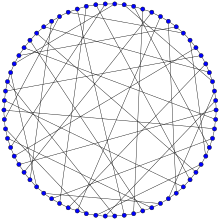In the mathematical field of graph theory, the Harries graph or Harries (3-10)-cage is a 3-regular, undirected graph with 70 vertices and 105 edges.[1]
| Harries graph | |
|---|---|
 The Harries graph | |
| Named after | W. Harries |
| Vertices | 70 |
| Edges | 105 |
| Radius | 6 |
| Diameter | 6 |
| Girth | 10 |
| Automorphisms | 120 (S5) |
| Chromatic number | 2 |
| Chromatic index | 3 |
| Genus | 9 |
| Book thickness | 3 |
| Queue number | 2 |
| Properties | Cubic Cage Triangle-free Hamiltonian |
| Table of graphs and parameters | |
The Harries graph has chromatic number 2, chromatic index 3, radius 6, diameter 6, girth 10 and is Hamiltonian. It is also a 3-vertex-connected and 3-edge-connected, non-planar, cubic graph. It has book thickness 3 and queue number 2.[2]
The characteristic polynomial of the Harries graph is
History
editIn 1972, A. T. Balaban published a (3-10)-cage graph, a cubic graph that has as few vertices as possible for girth 10.[3] It was the first (3-10)-cage discovered but it was not unique.[4]
The complete list of (3-10)-cage and the proof of minimality was given by O'Keefe and Wong in 1980.[5] There exist three distinct (3-10)-cage graphs—the Balaban 10-cage, the Harries graph and the Harries–Wong graph.[6] Moreover, the Harries–Wong graph and Harries graph are cospectral graphs.
Gallery
edit-
The chromatic number of the Harries graph is 2.
-
The chromatic index of the Harries graph is 3.
-
Alternative drawing of the Harries graph.
-
Alternative drawing emphasizing the graph's 4 orbits.
References
edit- ^ Weisstein, Eric W. "Harries Graph". MathWorld.
- ^ Jessica Wolz, Engineering Linear Layouts with SAT. Master Thesis, University of Tübingen, 2018
- ^ A. T. Balaban, A trivalent graph of girth ten, J. Combin. Theory Ser. B 12, 1-5. 1972.
- ^ Pisanski, T.; Boben, M.; Marušič, D.; and Orbanić, A. "The Generalized Balaban Configurations." Preprint. 2001. [1].
- ^ M. O'Keefe and P.K. Wong, A smallest graph of girth 10 and valency 3, J. Combin. Theory Ser. B 29 (1980) 91-105.
- ^ Bondy, J. A. and Murty, U. S. R. Graph Theory with Applications. New York: North Holland, p. 237, 1976.
